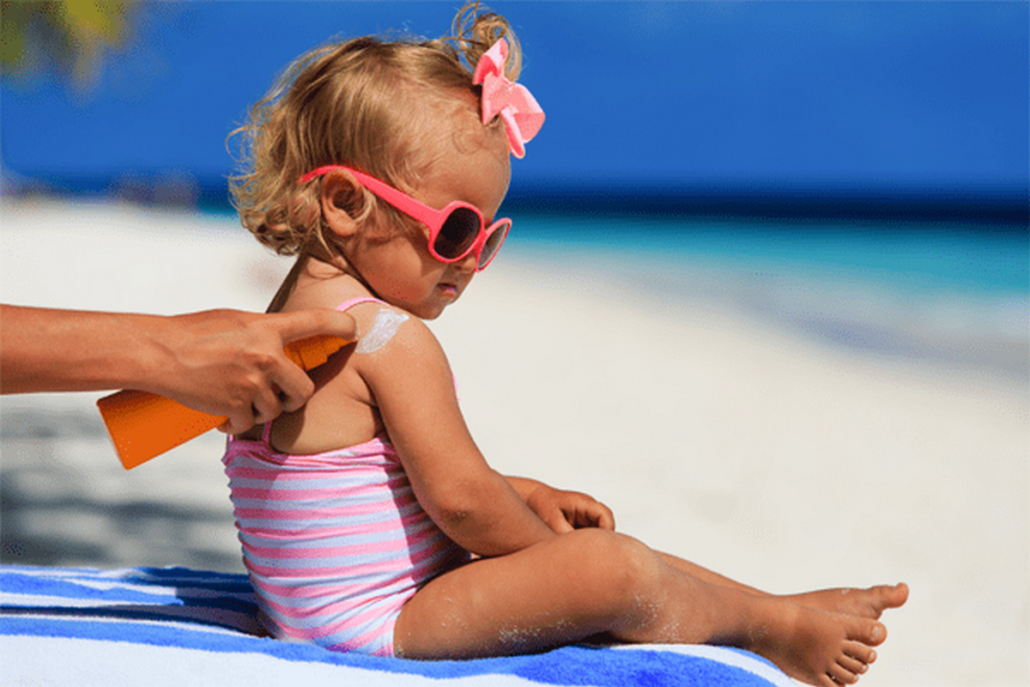
With so many conflicting recommendations out there about SUN, babies, and sunscreen, it’s hard to know what to do. Thus: Your guide has arrived! Yesssss!
Protecting Sensitive Skin from the Sun
Since unprotected sun exposure is the most preventable risk factor for skin cancer, it’s something to take pretty seriously. Heck, I wish someone had given me the memo about this when I was a kid; maybe I would have reconsidered daily tanning (burning?) contests with my sister. As someone who grew up in the South, LIVING at the pool every day… let’s just say we can do better with this generation of kids.
But it’s not just skin. In fact, “children under 10 are at a high risk for… eye damage from UV rays. And until about age 10, the lens of a child’s eye is clear, allowing greater solar penetration and thus greater UVR-induced ocular changes,” explains Adelaide A. Hebert, MD, professor and vice chair of dermatology, University of Texas Medical Center at Houston [SkinCancer.org].
Best Sun Protection for Young Babies (0-6 months)
“I’ve read I can’t use sunscreen until 6 months, and I’ve got a family beach vacation coming up. What should I do?”
Because of baby’s delicate skin, it’s true that the AAD (American Academy of Dermatology) recommends keeping babies < 6 months out of the sun and using minimal amounts of sunscreen, but don’t cancel your beach vacation [oh no]. Keep those babies out of direct sunlight with an umbrella or a sun tent and use hats, sun protective clothing (like a long-sleeved shirt for the sun), and small amounts of sunscreen when you must.
Sun Protection Beach Tents
At 3 weeks old, [then] baby Annora spent many an afternoon chilling in our beach tent and wiggling around in the sand. If you’re on a budget, I recommend the Coleman Road Trip Beach Shade (reg. $37, below). If you can spend a little more ($75), the WolfWise UPF 50+ Easy Pop Up 4 Person Beach Tent is the most highly-rated. This is a super lightweight tent that is truly “pop-up”, and uses sand to anchor it in the wind. We like this one because it has good ventilation.
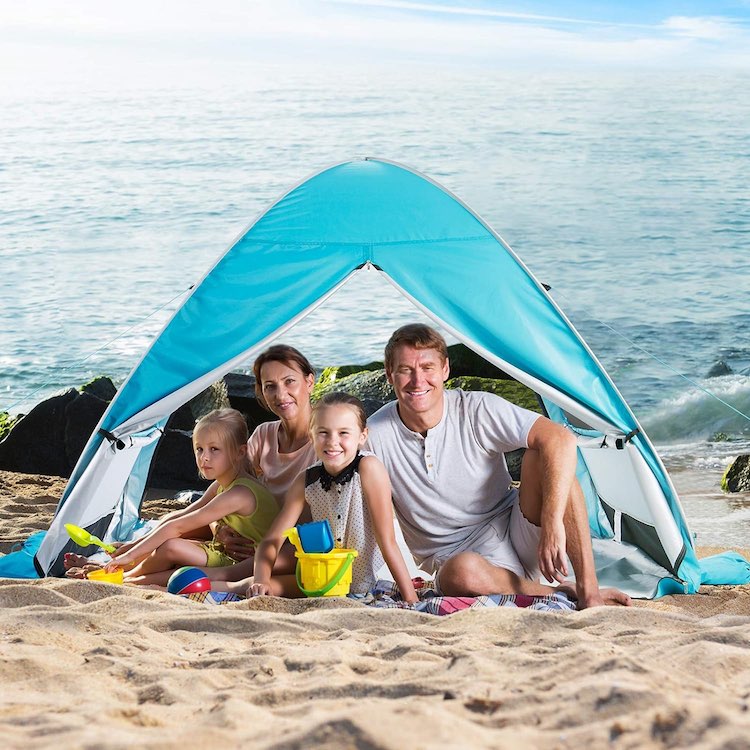
Just make sure the material is UV rated; otherwise, your baby can still get burned through the tent material. FYI, they can also get burned from sun reflecting off the sand and water.
What Type of Sunscreen is Best for Babies and Toddlers?
What’s the Difference between Sunscreen and Sunblock?
Technically speaking, sunscreens use chemicals to absorb UV rays so they don’t penetrate the skin, while sunblocks use minerals, such as titanium dioxide or zinc oxide, to physically deflect rays from the skin. However, these terms are often used interchangeably, so it’s a little confusing. Case in point: all of the recommended kids’ “sunscreens” below are technically sunblocks, but many refer to them as “mineral sunscreens.” So, yeah, just… FYI.
Sunblocks are generally recommended for babies and children (over sunscreens) by pediatricians, advocacy groups, environmentalists, etc. for various reasons.
The general sentiment is this: natural mineral (aka physical) sunblock is, by far, the safest option to get your SPF. The minerals zinc and titanium sit on the skin’s surface and reflect sun rays out away from the body like tin foil.
vs.
Ingredients in chemical sunscreens are absorbed into the skin to deal with sun rays in a chemically reactive process in the skin cell itself, with potentially unintended and harmful consequences to the skin and body.
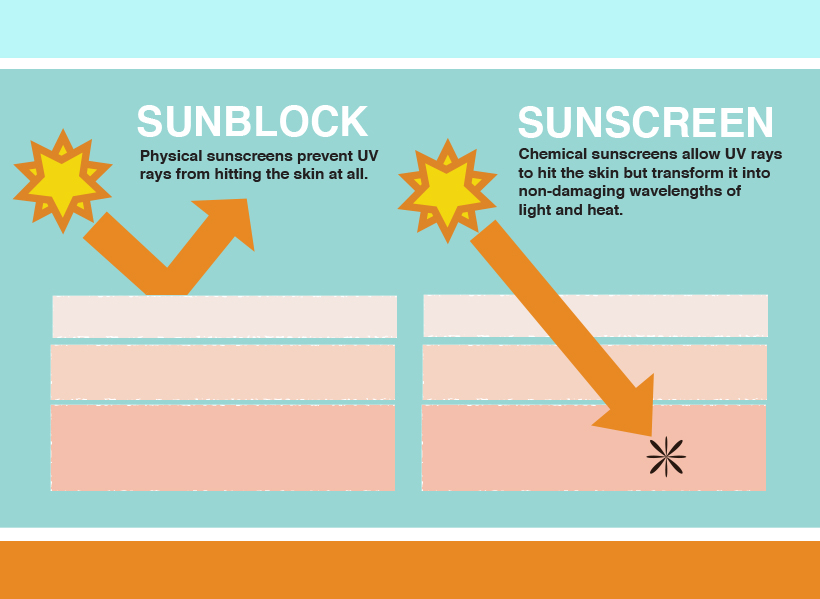
The downside to sunblocks is that they are generally more expensive because of the cost of the minerals used to make them. Just note that a little goes a long way, and a single tube or two could last you the whole season.
Screens and blocks for kids come in lotions, sprays, and sticks.
Everyone has their preferences, but I prefer lotions for infants — and sprays for kids-who-can’t-sit-still. Sticks are great for the face. The best way to do it is to apply sunscreen before you dress your child so you can get all the nooks and crannies (for girls, under swimsuit straps, etc.).
Best Sunscreen for Infants, Toddlers and Children
Baby Sunscreen: Lotions
Thinkbaby Sunscreen SPF 50+ ~ $8 (3 oz)
This is one of the best baby sunscreens ever — and the highest-rated sunscreen on multiple sites, with nearly 7,000 reviews on Amazon averaging 4.4/5 stars. Thinkbaby offers broad spectrum UVA/UVB protection with SPF 50+, and it’s “very water resistant” (up to 80 minutes in the water). ThinkBaby is paraben- and PABA-free, and it received an “excellent” for UVA and SPF protection from EWG’s “Skin Deep” scores, updated in January of 2024. Note also that it has been re-labeled/re-branded this year (2024).
Best of all, I should note that many sunscreens (especially the mineral sunblocks) look great on paper, but may have a terrible consistency (sticky, goopy, etc.) when you apply it. Thinkbaby has a nice, creamy consistency and is super easy to apply, which is another reason it’s our #1 (for 6 years running, in fact). Bottom line: this is a terrific zinc oxide sunscreen.
* Active ingredient: Zinc Oxide 20% [Non-nano]
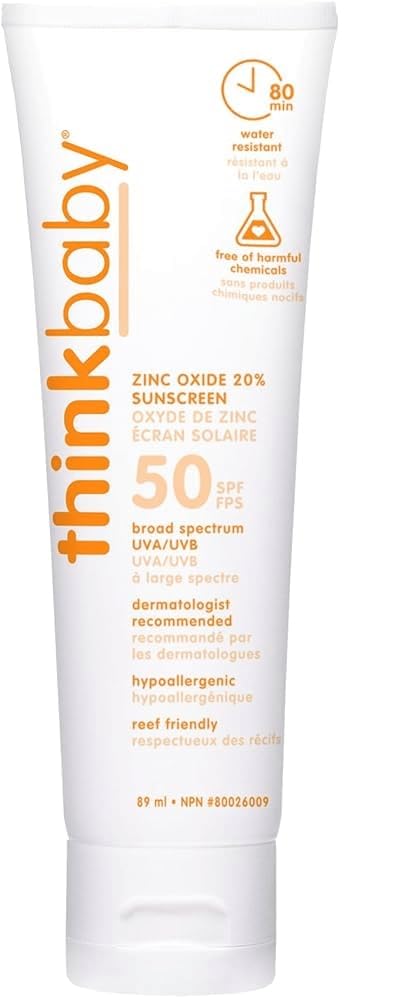

~ Can also be found at your local Whole Foods, Target, etc. *Note that Thinkbaby and Thinksport are exactly the same formula. They just want to confuse us, of course!
Blue Lizard Sensitive (or Baby) Sunscreen SPF 30+ ~ $14 (5 oz)
Australians, dogg.
Fair-skinned people living under a giant hole in the ozone know how to avoid a sunburn (slip, slap, slop!). Blue Lizard has been our go-to sunscreen since Lucie was born. This sensitive skin formulation, with no chemical absorbers, offers broad photostable UVA/UVB protection and protects skin for up to 4 hours of activity. Paraben and PABA-free.
* If water resistance is of the utmost importance, check out the Sport version, which is water-resistant up to 240 minutes. To be honest, nobody can tell us what the difference is in the “Baby” vs. “Sensitive” versions of this product, so I get whichever one is cheaper.
* Active ingredients: 10% Zinc Oxide and 5% Titanium Dioxide [Non-nano]
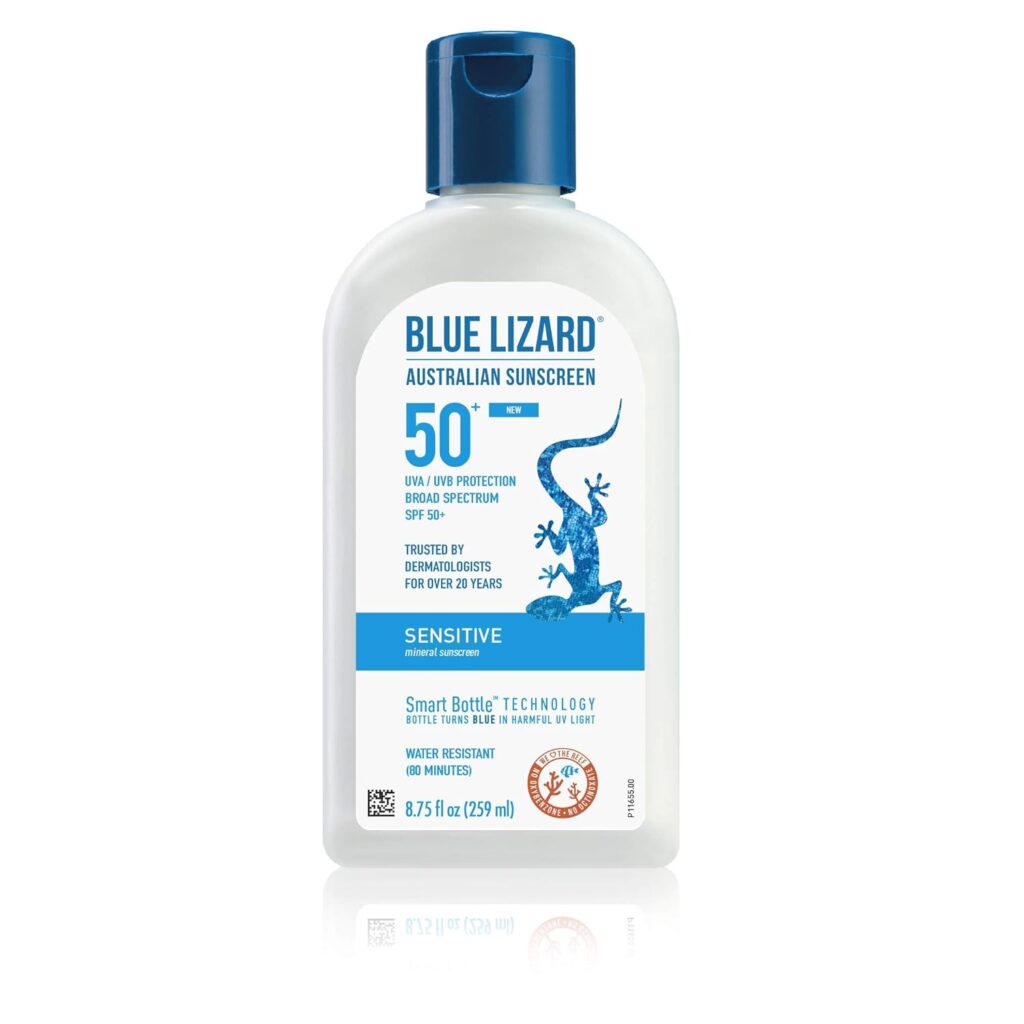

BabyBum Sunscreen SPF 50 ~ $14 (3 oz)
Naturally fragrance-free, this broad spectrum sunscreen is the perfect answer to all of your sensitive skin needs. Consistency is light and non-sticky, and won’t make your kiddos feel all chalky. Apply 15 minutes before sun exposure, and reapply every 2hrs. It’s water and sweat resistant for 80 minutes.
* For folks who prefer a stick sunscreen, BabyBum’s is well-priced and easy to apply. It’s a bit chalkier than its lotion counterpart, but just as effective.
* Active Ingredient: Zinc Oxide 20% [Non-nano]
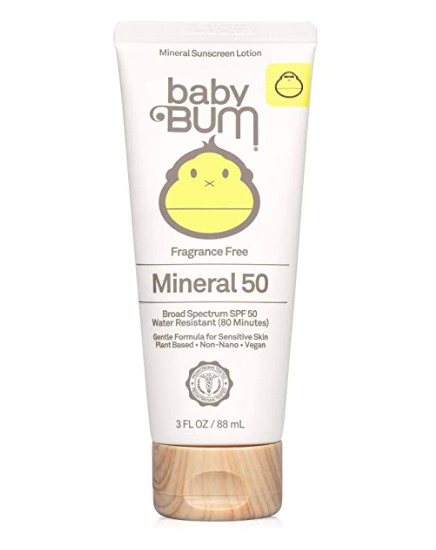

Baby Sunscreen: Sprays
Sprays are sometimes easier to apply, just generally not the favorite of experts because 1). they can be inhaled and 2). none of them are totally free of the “bad 6 chemicals to look out” for (avobenzone, homosalate, octisalate, octocrylene, octinoxate, and the baddest of them all: oxybenzone).
But many people love a spray because it’s all they can muster with a squirmy kid. Mind you, kid’s sprays still have to be rubbed in, unlike some of the toxic adult versions. Kidding (sort of).
That said, if you must spray, we choose:
BabyGanics Mineral-Based Sunscreen Spray SPF 50+ ~ $19 (pack of 2! 6 oz)
Water resistant for 80 minutes and SPF 50+, this kid-friendly sunscreen is great for long days at the beach or pool. Contains no PABA, parabens, or phthalates. It offers broad spectrum UVA/UVB protection and is easy to apply. Non-allergenic and tear free. *Also available as a stick.
* Active ingredients: Octinoxate 7.5%, Octisalate 5.0%, Zinc Oxide 11.2% [Non-nano]

Again, the big benefit of using a spray is that I can hold my kid’s hair (or swimsuit straps) while I spray with one hand. With lotions and creams, you most definitely need to use two hands. It’s this convenience that I like. There are some reviews saying it doesn’t work well, but that has never been my experience.
* There is a concern about using sprays with nano-particles on children because they could be inhaled. This formulation is non nano zinc oxide — but regardless, make sure your child doesn’t inhale it (or any other sprays, for that matter).
FYI — There are lots of good sunblocks out there, but many of them are only available through specialty websites. Do you have one you love? Please leave a comment below, thanks!
Remember: Sunscreen is just part of the equation that also includes protective clothing, hat and eye protection, and staying out of the sun when the rays are strongest, between 10 am and 3 pm, generally.
Sunscreen Safety Controversies
The two main controversies of sunscreens (particularly for children) look something like this:
The Nanoparticle Debate
Over the past decade or so, there’s been a lot of talk about the safety of “nanoparticles,” especially when it comes to nano zinc oxide. You see, in the past, mineral sunblocks consisted of large enough particles that they always remained white and chalky on the skin.
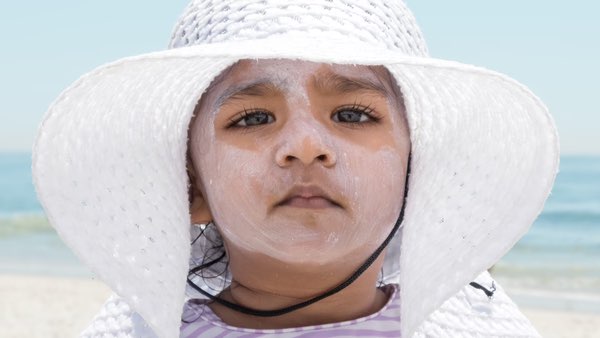
More recently, many products have been formulated to reduce the size of the mineral particles, called nanoparticles, making them less visible on the skin. No more ghostly white-face — yay, right?
However, there are concerns that nanoparticles may possibly pass THROUGH the skin (especially in pre-term babies and very young babies) and may be photo-reactive, forming free radicals that can cause cell damage. Those espousing this position recommend using only mineral sunblocks that contain “micronized” particles rather than nanoparticles. [Technically, a nanoparticle is any particle less than 100 nanometers in diameter, but a particle must actually be less than 50 nanometers to enter skin cells, less than 70 nanometers to enter the lungs, etc.] Got it? Okay good.
Recent research (as of 2024) and evidence suggests that ZnO and TiO2 nanoparticles in sunscreens are *generally* safe for human use (and kids/babies) when applied topically. Just in case, *All the products I recommend [above] are NON-nano (in case you were wondering what the heck that means).
No she-NANO-gans here, mama. I’m hilarious, I know.
Oxybenzone
The good news is that oxybenzone is one of the few FDA-approved ingredients that provide effective broad-spectrum protection (see #3) from UV radiation. The bad news is that oxybenzone might be an endocrine disruptor, which could affect the nervous system, has been linked to cancer in some laboratory studies, and creates free-radicals when exposed to the sun. In fact, the American Academy of Pediatrics warns against oxybenzone for children because of concerns about mild hormonal properties.
The jury is out on this one as well.
The latest research, as of 2024, suggests that while oxybenzone is effective at providing sun protection, its potential health risks and environmental impact have led to increasing scrutiny and calls for safer alternatives. So… yeah. *All of the products we recommend [above] are free of oxybenzone. Just in case.
Some research still indicates that short-term use in humans did not show any adverse effect.” However, it [no doubt] makes for a highly-effective sunscreen. Therefore, if oxybenzone is not a concern for you personally, save some dollars and go with Coppertone Water Babies or even Equate by WalMart.
Many sunscreens only protect from UVB rays…
This is giving people a false sense of security about spending time in the sun. UVA radiation doesn’t cause sunburns per se, but can increase the rate of melanoma and AGING of the skin (ack!), so many people using sunscreens may be exposed to high UVA levels without realizing it.
Look for sunscreens with broad-spectrum (UVA/UVB) protection (for adults too)! Natural sunscreen ingredients, including zinc oxide and titanium dioxide protect from both UVA and UVB overexposure. Do I have your back or what?
So go get your kiddies some sunscreen and enjoy the summer!
0 Comments